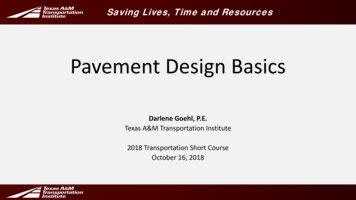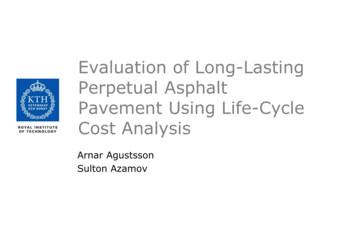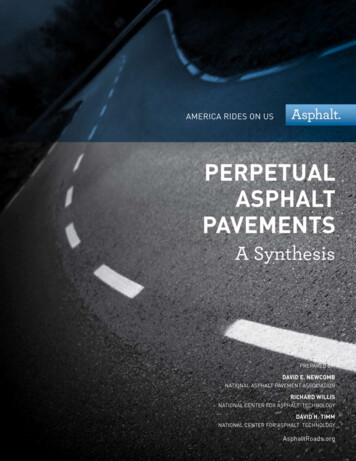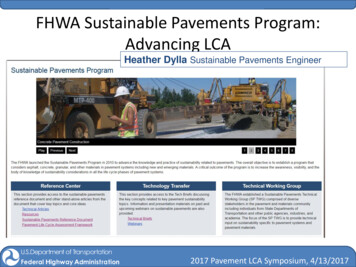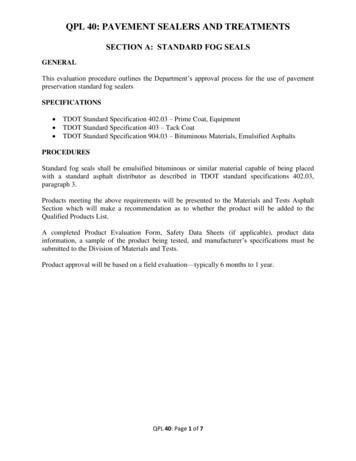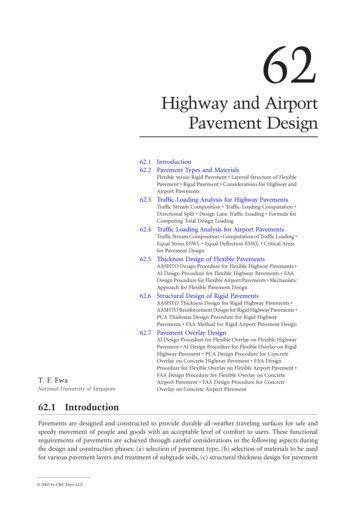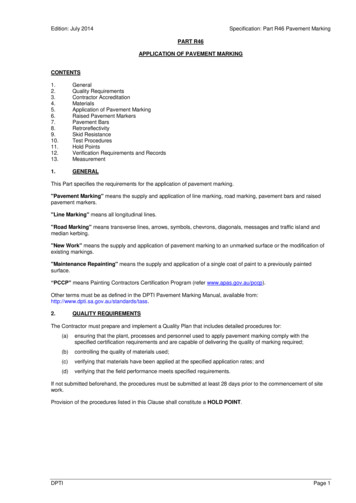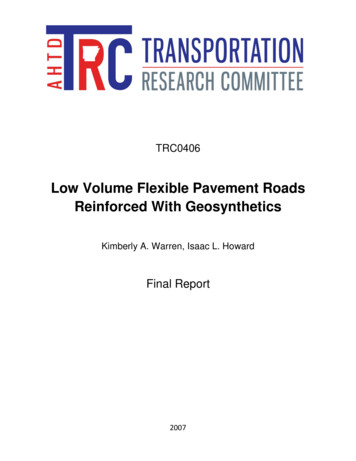
Transcription
TRC0406Low Volume Flexible Pavement RoadsReinforced With GeosyntheticsKimberly A. Warren, Isaac L. HowardFinal Report2007
FINAL REPORT: AHTD TRC-0406LOW VOLUME FLEXBILE PAVEMENT ROADSREINFORCED WITH GEOSYNTHETICSSubmitted by:Kevin D. Hall, Ph.D., P.E.Department Head, Civil EngineeringUniversity of Arkansas4190 Bell EngineeringFayetteville, Arkansas 72701Authors:Kimberly A. Warren, Ph.D.Assistant Professor, Civil EngineeringUNC Charlotte9201 University City Boulevard, Cameron 120Charlotte, North Carolina 28223Isaac L. Howard, Ph.D.Assistant Professor, Civil EngineeringMississippi StateP.O. Box 9546Mississippi State, Mississippi 39762
TABLE OF CONTENTS1.INTRODUCTION1.1.General and Background Information1.2.Research Objectives1-11-11-22.LITERATURE REVIEW2.1.Introduction2.2.Field Testing for Geosynthetic-Reinforced Paved Roads2.3.Laboratory Studies2-12-12-22-93.TEST SITE AND MATERIAL PROPERTIES3.1.Site Location3.2.Soil Characterization3.3.UU Triaxial Testing3.4.CU Triaxial Testing3.5.Resilient Modulus3.6.FWD Testing3.7.Crushed Stone (Base Course)3.8.Asphalt Concrete Properties3.9.Test INSTRUMENTATION4.1.Introduction4.2.Gage Identification4.3.Earth Pressure Cell4.4.Asphalt Strain Gage4.5.Foil Strain Gages4.6.Thermocouples4.7.Moisture Content Probes4.8.Piezometers4.9.Tipping Bucket4.10.Piezoelectric LL-SCALE FIELD CONSTRUCTION5.1.Introduction5.2.Subgrade Preparation5.3.Geosynthetic Placement5.4.Base Course5.5.Asphalt Concrete5.6.Cable Management and Protection5-15-15-15-25-55-65-86.DATA ACQUISITION6.1.Introduction6.2.Data Acquisition Hardware6.3.Data Acquisition Software Overview6.4.Data Acquisition Logic6.5.Pilot Scale Study6.6.Data Acquisition Programming6-16-16-16-36-46-56-9ii
6.7.6.8.Hardware GlitchesFull-Scale Field Implementation6-156-167.DATA COLLECTION AND MANAGEMENT7.1.Data Collection7.2.File Identification and Description7.3.File conversion and Hierarchy7.4.File Formatting7.5.Temperature Analysis7.6.Data Filtering7.7.Data Consolidation7-17-17-87-127-127-147-157-218.DATA ANALYSIS8.1.Introduction8.2.Environmental Data8.3.Transfer Functions8.4.Asphalt Strain Response8.5.Earth Pressure Response8.6.Geosynthetic Strain Response8.7.The Observed Versus the Calculated Pavement Condition8-18-18-18-48-98-168-228-239.FINITE ELEMENT MODEL DEVELOPMENT9.1.Methodology9.2.Material Constitutive Models9.3.Boundary Conditions and Geometry9.4.Mesh9.5.Load Application9.6.Constant Material Model Inputs9.7.Variable Material Model Inputs9-19-19-39-89-99-139-149-1610.FINITE ELEMENT ANALYSIS RESULTS10.1.Introduction10.2.FEA Model Responses10.3.Comparison of FEA and Measured Responses under FWD Loads10.4.Comparing FEA and Measured Responses under Traffic Loads10.5.Model Calibration with Field Data10.6.Comparison of Traffic and FWD ARY AND endations for Future Research11-111-111-311-512.12-1REFERENCESiii
LIST OF TABLESPageTable 3.1 – Local Climate InformationTable 3.2 –Laboratory Test Results from Bulk SamplesTable 3.3 – Laboratory Test Results from Split Spoon and Shelby Tube SamplesTable 3.4 – Subgrade Nuclear Gauge ReadingsTable 3.5 –Unconsolidated Undrained Testing ResultsTable 3.6 – Resilient Modulus Test Results for Section 1Table 3.7 – Resilient Modulus Test Results for Section 13 (Compacted Subgrade)Table 3.8 – Resilient Modulus Test Results for Section 13 (Natural Subgrade)Table 3.9 – Subgrade Resilient Modulus Values Back-Calculated from FWD DataTable 3.10 – Crushed Stone PropertiesTable 3.11 – Asphalt Concrete Material able 4.1 – Research InstrumentationTable 4.2 – Gage and Cable Identification SchemeTable 4.3 – Geokon Model 3500-2 Product SpecificationsTable 4.4 – Asphalt Strain Gage SpecificationsTable 4.5 – Decagon EC-20 Product SpecificationsTable 4.6 – Piezometer SpecificationsTable 4.7 – Tipping Bucket and Collector Product SpecificationsTable 4.8 – MSI Roadtrax BL Class 1 Sensor Product Specifications4-24-34-44-94-194-234-264-27Table 5.1 – Final Base Course ThicknessesTable 5.2 – Final Asphalt Thickness5-65-9Table 7.1 – Data Acquisition Output FormatTable 7.2 – Data Acquisition NomenclatureTable 7.3 – Ambient Temperature Regression EquationsTable 7.4 – Asphalt Temperature Regression Equations7-107-117-167-17Table 8.1 – Rainfall Record for NE ArkansasTable 8.2 –Moisture Contents Obtained from Section 7 CoresTable 8.3 – Test Section Constant Weighted Average ValuesTable 8.4 – Asphalt Strain Response CalculationsTable 8.5 – Relative Fatigue Cracking Performance for All Test SectionsTable 8.6 – Relative Fatigue Cracking Performance for Sections 1b-6Table 8.7 – Relative Fatigue Cracking Performance for Sections 8-13bTable 8.8 – Base Course Earth Pressure Responses*Table 8.9 – Subgrade Earth Pressure Responses*Table 8.10 – Relative Permanent Deformation Performance for All SectionsTable 8.11 – Relative Permanent Deformation Performance for Sections 1b-6Table 8.12 – Relative Permanent Deformation Performance for Sections 8-13bTable 8.13 – Subgrade Stress RatiosTable 8.14 – Surveyed Rut Depths (On Sensors)Table 8.15 – Surveyed Rut Depths (Near Sensors)Table 8.16 – Final Measured Rut Depth (ASTM E1703)Table 8.17 – Rut Damage Evaluation for All Test SectionsTable 8.18 – Rut Damage Evaluation for Sections 1b-6Table 8.19 – Rut Damage Evaluation for Sections 8-13bTable 8.20 – Measured and Calculated Permanent Deformation 28-238-248-258-258-268-278-278-28iv
PageTable 9.1 – Asphalt Concrete Constitutive ModelsTable 9.2 – Geometric Zones Used in the ModelTable 9.3 – Constant Inputs Used in the FEA ModelTable 9.4 – Geosynthetic Axial Stiffness Values9-49-119-159-17Table 10.1 – Measured (FWD) and Calculated Vertical Surface Deflections (Under the Load)Table 10.2 – Measured (FWD) and Calculated Asphalt Strain Responses (Under the Load)Table 10.3 – Measured (FWD) and Calculated Asphalt Strain Responses (30 cm from theLoad)Table 10.4 – Measured (FWD) and Calculated Crushed stone Pressure Responses(Under the Load)Table 10.5 – Measured (FWD) and Calculated Crushed stone Pressure Responses(30 cm from the Load)Table 10.6 – Measured (FWD) and Calculated Compacted Subgrade Pressure Responses(Under the Load)Table 10.7 –Measured (FWD) and Calculated Compacted Subgrade Pressure Responses(30 cm from the Load)Table 10.8 –Calculated Geosynthetic Strain Response Ranges from FWD LoadsTable 10.9 – Measured (Traffic) and Calculated Asphalt Strain Responses (Under the Load)Table 10.10 – Measured (Traffic) and Calculated Crushed stone Pressure Responses(Under the Load)Table 10.11 – Measured (Traffic) and Calculated Compacted Subgrade Pressure Responses(Under the Load)Table 10.12 – Calculated Geosynthetic Strain Response Ranges from Traffic LoadsTable 10.13 – Model Calibration Equations under FWD LoadsTable 10.14 – Model Calibration Equations under Traffic LoadsTable 10.15 – Comparison of FWD and Traffic Calibrations (Under 310-2410-2510-2610-3310-3810-41
LIST OF FIGURESPageFigure 3.1 – Test Site Location in Arkansas (District 10)Figure 3.2 – Test Site Prior to ConstructionFigure 3.3 – Soil Sample Locations for Strength TestingFigure 3.4 – UU Triaxial Results for a Soil Obtained from Zone 2Figure 3.5 – CU Triaxial Results for Soil Obtained in Zone 2Figure 3.6 – Resilient Modulus Test Results for Zone 4 (20.7% Water Content)Figure 3.7 – Plan View of the Test ConfigurationFigure 3.8 – Profile View of the Test Configuration3-23-23-63-83-93-103-183-18Figure 4.1 – Profile View of the Test Configuration with InstrumentationFigure 4.2 – Earth Pressure CellFigure 4.3 – Installed Subgrade Earth Pressure CellFigure 4.4 – Re-Location Technique Used in the Base CourseFigure 4.5 – Installed Base Course Earth Pressure CellFigure 4.6 – TamperFigure 4.7 – Asphalt Strain GageFigure 4.8 – Asphalt Strain Gage Pair Prior to PavingFigure 4.9 – Bottom Asphalt Cushion and Alignment NailFigure 4.10 – Strain Gage Installation In ProgressFigure 4.11 – Foil Strain GagesFigure 4.12 – Geogrid Strain Gage in the FieldFigure 4.13 – Geotextile Strain Gage in the FieldFigure 4.14 – Geotextile Strain Gage in the FieldFigure 4.15 – Subgrade Thermocouples Attached to a PVC PipeFigure 4.16 – Base Course ThermocouplesFigure 4.17 – Asphalt ThermocouplesFigure 4.18 – Moisture Content ProbeFigure 4.19 – Insertion of Metal Bar with Leverage RodFigure 4.20 – Insertion of Subgrade Moisture Content ProbeFigure 4.21 – Insertion of Base Course Moisture Content ProbeFigure 4.22 – PiezometerFigure 4.23 – Geotextile Bag for the PiezometerFigure 4.24 – Placement of the PiezometerFigure 4.25 – Installed Tipping BucketFigure 4.26 – Piezoelectric SensorFigure 4.27 – Pavement SawFigure 4.28 – Installed Piezoelectric -284-284-29Figure 5.1 – Finished SubgradeFigure 5.2 – Relocation of the Instrumentation LocationFigure 5.3 – Geosynthetic Lay Down TechniqueFigure 5.4 – Aggregate PlacementFigure 5.5 – Final Base Course with Asphalt Strain GagesFigure 5.6 – Paving in ProgressFigure 5.7 – Data Acquisition EnclosuresFigure 5.8 – Lateral Pipe Extending From the Shoulder to the HeaderFigure 5.9 – Junction Located at the Base of the LateralFigure 5.10 – Pipe Feeding ProcessFigure 5.11 – Redressing the Side Slopes5-25-35-45-55-75-85-105-125-135-145-15vi
PageFigure 6.1 – Data Acquisition SystemFigure 6.2 – Pilot Scale Traffic Responses in the Asphalt and SubgradeFigure 6.3 – Detailed Asphalt Strain ResponseFigure 6.4 – Programming Flow ChartFigure 6.5 – Example Block Diagram6-26-66-96-116-12Figure 7.1 – Single Axle Dump Truck on the ScaleFigure 7.2 – Falling Weight Deflectometer TestFigure 7.3 – Asphalt Strain Response to FWD Testing SequenceFigure 7.4 – Earth Pressure Response to FWD Testing SequenceFigure 7.5 – Asphalt Strain Response to One FWD DropFigure 7.6 – Earth Pressure Response to One FWD DropFigure 7.7 – Asphalt CoringFigure 7.8 – File Hierarchy for Phase B, Sequence 2, Section 5Figure 7.9 – Formatted File for Section 5Figure 7.10 – Sequence B-7 Ambient and Asphalt Temperature CurvesFigure 7.11 – Filtered Data (Phase B, Sequence 3, Section 13b)Figure 7.12 – Unfiltered Data with Axle Assignments (Phase B, Sequence 3, Section 13b)Figure 7.13 – Axle Assignment Quality Control ChecksFigure 7.14 – Example of a Summary TableFigure 7.15 – Summary Table (Phase A, Rear Axle, Sequence 4, Section 17-23Figure 8.1 – Two Triggered Asphalt Strain ResponsesFigure 8.2 – Average Asphalt Strain “Response Interval” Per SubsetFigure 8.3 – Range of Asphalt Strain “Response Interval” Per SubsetFigure 8.4 – Normalized Asphalt Strain RangeFigure 8.5 – Two Triggered Earth Pressure Responses8-108-138-148-148-17Figure 9.1 – Axis-Symmetric Configuration in 3D (a) and as a Single Plane (b)Figure 9.2 – Geometric Zones Created for the ModelFigure 9.3 – Mesh ConfigurationFigure 9.4 – Localized Mesh Near the LoadFigure 9.5 – Transient Force Representing an FWD Load Pulse9-29-109-119-129-14vii
PageFigure 10.1 – Deflection Basin under a 40 KN Drop Load in Section 13Figure 10.2 – Calculated Vertical Pressure Responses (Under Load)Figure 10.3 – Calculated Vertical Pressure Responses (Offset)Figure 10.4 – Asphalt Strain Responses with Depth (Under Load)Figure 10.5 – Asphalt Strain Responses with Depth (Offset)Figure 10.6 – Normalized Asphalt Strain with Depth (Section 13)Figure 10.7 – Typical Geosynthetic Strain ResponseFigure 10.8 – Average Deflection Basins (Phase 1, Sections 1b-6, 40 KN Load)Figure 10.9 – Average Deflection Basins (Phase 1, Sections 8-13b, 40 KN Load)Figure 10.10 – Average Deflection Basins (Phase 2, Sections 1b-6, 40 KN Load)Figure 10.11 – Average Deflection Basins (Phase 2, Sections 8-13b, 40 KN Load)Figure 10.12 – Average Deflection Basins (Phase 3, Sections 1b-6, 40 KN Load)Figure 10.13 – Average Deflection Basins (Phase 3, Sections 8-13b, 40 KN Load)Figure 10.14 – Average Deflection Basins (Phase 4, Sections 1b-6, 40 KN Load)Figure 10.15 – Average Deflection Basins (Phase 4, Sections 8-13b, 40 KN Load)Figure 10.16 – All Measured (FWD) versus Calculated Deflections (Under Load)Figure 10.17 – All Measured (FWD) versus Calculated Asphalt Strains (Under Load)Figure 10.18 – All Measured (FWD) versus Calculated Asphalt Strains (Offset)Figure 10.19 – All Measured (FWD) versus Calculated Crushed stone Pressures (Under Load)Figure 10.20 – All Measured (FWD) versus Calculated Crushed stone Pressures (Offset)Figure 10.21 – All Measured (FWD) versus Calculated Subgrade Pressures (Under Load)Figure 10.22 – All Measured (FWD) versus Calculated Subgrade Pressures (Offset)Figure 10.23 – Select Measured (FWD) versus Calculated Asphalt Strains (Under Load)Figure 10.24 – Select Measured (FWD) versus Calculated Asphalt Strains (Offset)Figure 10.25 – Select Measured (FWD) versus Calculated Subgrade Pressured (Under Load)Figure 10.26 – Select Measured (FWD) versus Calculated Subgrade Pressures (Offset)Figure 10.27 – All Measured (Traffic) versus Calculated Asphalt Strains (Under Load)Figure 10.28 – All Measured (Traffic) versus Calculated Crushed stone Pressures (UnderLoad)Figure 10.29 – All Measured (Traffic) versus Calculated Subgrade Pressures (Under Load)Figure 10.30 – Select Measured (Traffic) versus Calculated Asphalt Strains (Under Load)Figure 10.31 – Select Measured (Traffic) versus Calculated Subgrade Pressures (Under Load)Figure 10.32 – Modified Measured (Traffic) Versus Calculated Subgrade Pressures -3610-3710-3710-39
1. INTRODUCTION1.1 General and Background InformationIn general, low-volume, flexible pavement roadways typically consist of somecombination of a natural soil subgrade, granular base course, and asphalt concretesurface.Weak subgrade soils commonly pose a problem for the transportationengineering community since the subgrade serves as a foundation to the pavementstructure.Conventionally, poor quality materials are excavated and replaced oralternative soil stabilization techniques are used. However, these methods can belabor and cost intensive especially if adequate replacement material is not available inthe area. Geotextiles and geogrids offer alternative solutions to these conventionalsolutions.Geosynthetic materials are commonly used to improve Civil Engineeringdesign for various transportation, geotechnical, hydraulic, and environmentalapplications. Fabric reinforcement dates as far back as 1926 when the South CarolinaDepartment of Transportation used natural cotton fibers to reinforce a roadway. Untilthe cotton fibers deteriorated, the roads remained in good condition, and roadwaycracking, raveling, and localized failures were reduced (Koerner, 1986; Kaswell,1963).The properties and performance of synthetic fibers has improved significantlyover the last 30 years and the increasing popularity of these materials can be attributedto their high strength, chemical resistance, and relatively low cost (Koerner, 1986).Both geotextiles and geogrid materials provide additional tensile reinforcement andconfinement to the pavement system, ultimately reducing deformation and stresstransfer from the surface to the subgrade.Geotextiles that are installed at thesubgrade-base course interface also provide filtration and separation betweendissimilar materials. Vehicular loads imposed on poor quality, saturated soils tend toincrease existing pore pressures, decrease soil strength, reduce the bearing capacity,and promote the migration of subgrade fines into the base course layer. As a result,the initial design thickness and the drainability of the pavement structure is sacrificed.1-1
The pumping of fines into the aggregate will eventually result in surface roughness,rutting, cracking, and eventual loss of load carrying capacity (Al-Qadi et al., 1996;Perkins and Ismeik 1997).According to FHWA (1990), FHWA (2001), and Huang (1993), approximately94% - 97% of the 2.5 million miles of paved US roads are surfaced with asphalt.Additional field testing is needed to further investigate the effects of each performancemechanism (separation versus reinforcement), demonstrate the performance of thesematerials under a variety of conditions, and collect stress-strain data for calibration ofthe upcoming mechanistic-empirical design approach.As a result, the Arkansas Highway and Transportation Department (AHTD)initiated the construction of a full-scale test site consisting of thirteen test sections inJuly of 2003. Prior to construction, MIRAFI Construction Products expressed aninterest in adding an additional four test sections to the test site.After someconstruction delays, seventeen test sections were constructed in the summer of 2005.1.2 Research ObjectivesIn order to develop a better understanding of geosynthetic-reinforced flexiblepavements and conduct high quality research in a field environment, the followingobjectives were systematically executed. Each objective/task is described in moredetail within the chapters highlighted at the end of each objective.1. Conduct a Literature Review: A review of the literature pertaining to all fieldexperimentation, laboratory testing, and modeling efforts for the currentapplication was performed in 2003 to establish the current state of practice atthe time the project was initiated (Chapter 2).2. Develop an Instrumentation and Plan: A detailed instrumentation plan wasdeveloped to establish the type, quantity, location, and installation method forall gages utilized in this study (Chapter 4).1-2
3. Calibrate and Prepare the Instrumentation:All sensors were properlycalibrated (or checked) and all foil strain gages were installed on thegeosynthetic materials, prior to field installation (Chapter 4).4. Install the Test Sections: An installation plan was developed to detail thespecial precautions used during for each phase of the construction process tomaximize gage survivability in the presence of harsh construction conditions(Chapter 5).5. Develop a Data Acquisition System and Develop the Software Code: A dataacquisition system was developed and extensive programming was required toseamlessly acquire data from each axle and test section using independent,section-specific trigger sensors. Additionally, the software was programmed tocalculate the critical statistics and organize the data files in an attempt to softenthe post processing effort (Chapter 6).6. Monitor, Collect, and Reduce the Data: Data was collected during three testphases over the course of four weeks, and a significant post-processing effortwas performed to organize the data into a manageable database, prior to anydata analysis (Chapter 7).7. Analyze the Field Data: An empirical data analysis was conducted usingAsphalt Institute transfer functions coupled with Miner’s Concept (Chapter 8).8. Establish the Governing Geosynthetic Performance Mechanisms: The choiceand configuration of the geosynthetic materials was developed to assess thegoverning performance mechanism under full-scale loading conditions.9. Develop a Finite Element Model: PLAXIS was utilized to develop a finiteelement model to predict critical structural responses of the geosyntheticreinforced flexible pavement test sections (Chapter 9).1-3
2. LITERATURE REVIEW2.1 IntroductionGeosynthetic materials are manufactured from polymers (hydrocarbons)including polyester (PE), polypropylene (PP), polyethylene (PE), polyamide (PA), andpolyvinyl chloride (PVC). The properties of these materials are monitored and testedduring the manufacturing process to ensure quality control of each product. Unlikenatural site materials, the properties of geosynthetics are well defined by themanufacturer. While there are a variety of innovative geosynthetic materials, the fourmost common classifications are geotextiles, geogrids, geomembranes, andgeocomposites, and the five primary geosynthetic functions include reinforcement,separation, filtration, drainage, and containment. The use of geotextiles and geogridswill be highlighted in this project.Geotextiles were originally developed as an alternative to granular soil filters(originating the term “filter fabrics”), allowing water to pass through the fabric whileretaining soil particles. Similarly, some geotextiles can be used as a drainage productcapable of dissipating excess pore pressures if the thickness and transmissivity of thematerial is adequate. They are also commonly placed between dissimilar materials toact as a separator. For example, a geotextile placed between a subgrade and basecourse layer prevents the migration of fine-grained particles into a coarse-grainedaggregate layer, which would compromise the integrity of the pavement structure. Ingeneral, soils possess little to no tensile strength. The addition of a geosyntheticmaterial provides additional reinforcement to the Civil Engineering system.In general, geogrids are used for reinforcement and confinement. As discussedpreviously, soils and unbound aggregate have very little (if any) tensile strengthwithout the inclusion of additional reinforcement. In addition to the direct tensilestrength and confinement capability provided by a geogrid, the apertures “lock” theaggregate in place and create additional passive resistance. While there has beensignificant research advances in the area of geosynthetics, additional field testing isalways necessary to demonstrate the capabilities of synthetic materials. Geosynthetics2-1
can improve the design of many Civil Engineering applications and they are gainingpopularity in both the private and the public sector, but there is still hesitations(especially in the public sector) to use these materials.The incorporation ofgeosynthetics into our roadways is not a simple problem due to the wide range ofparameters that affect the performance of the material and the pavement structure.According to Perkins and Ismeik (1997), the geosynthetic type, manufacturingprocess, mechanical properties, material placement and layering, base course thicknessand quality, asphalt thickness, subgrade type, strength, and stiffness, and vehicularload magnitude and frequency are all contributing factors.A survey of publishedfield tests and laboratory experiments related to geosynthetic-reinforced flexiblepavements conducted at the initiation of this project is presented in the followingsections of this chapter. A literature review of existing numerical analysis was alsoperformed and is available upon request.2.2 Field Testing for Geosynthetic-Reinforced Paved Roads2.2.1 Field Test 1An eight year field study was initiated in 1994 by Virginia Tech on asecondary road in Bedford County, Virginia (Al-Qadi and Appea(2003), Al-Qadi andBhutta(1999), Brandon et al.(1996)). The study consisted of nine 15 m (50 ft) longtest sections with limestone base course material (VDOT 21-B). Each base coursethickness (100 mm (4 in), 150 mm (6 in), and 200 mm (8in)) contained threeconfigurations that included a geogrid, a geotextile, and a control test section. In allcases, the geosynthetic material was placed at the subgrade/base interface, the averagehot mix asphalt (HMA) thickness was 95 mm (3.75 in), the average California BearingRatio (CBR) value was 7, and the average annual daily traffic (AADT) wasapproximately 550 (5% trucks).Kulite 0234 and Carlson TP-101 earth pressure cells (0 to 690 kPa (0-100 lb/in2)operating stress level) were used (50% and 76% survivability rate, respectively).Carlson JO-1 horizontal strain gages were used in the soil at the surface of thesubgrade layers in the control sections (83% survivability rate).2-2Kyowa KM
horizontal strain gages were used at the bottom of the HMA wearing surface (74%survivability rate). Vishay Micro-Measurement N2A 06 40 CBY 120 foil strain gageswere attached to the bottom of the geotextiles (6% survivability rate) and TexasMeasurements FLK-6-1L foil strain gages were attached to the bottom of the geogrid(28% survivability rate). T-Type thermocouples (88% survivability rate) were used tomeasure temperature and Gypsum block moisture sensors measured water content(100% survivability rate). AMP Sensors Inc. Roadtrax Series P traffic sensors wereused to monitor and trigger traffic for the data acquisition system, which was aKeithley 500. The Quick Basic software handled a 200 Hz sampling rate.In general, test sections with a 100 mm (4 in) base experienced significantimprovement from the geogrids and geotextile inclusions while there was less of anaffect on pavements with a thicker base course. Using a 20 mm (0.79 in) rut depth asa failure criterion for the 100 mm (4 in) base sections, it was determined that thegeotextile and geogrid sections carried 195% and 187% more traffic than the control,respectively.However, the inclusion of geosynthetic materials did not preventexcessive deformation during the first few months, which is typical in comparison tothe same time interval at another stage of pavement life.Using the Falling Weight Deflectometer (FWD) data, the Base Damage Index (BDI)for the geotextile sections was approximately half the value calculated for control testsections. The BDI directly relates the pumping of fines into the base course from thesubgrade, which is a strength reduction mechanism. Furthermore, it was concludedthat improvements to the pavements as a result of the geosynthetics increased as thestudy progressed in comparison to control test sections.2.2.2 Field Test 2A field study along a 1.4 km section of Wisconsin State Highway 60 wasinitiated in the fall of 2000 (Edil et al. (2002)). Twelve test sections were constructedincluding three control, four industrial bi-product, and five geosynthetic test sections(a geocell, non-woven geotextile, woven geotextile, drainage geocomposite, and ageogrid). All test sections were designed with approximately the same structural2-3
number as the control ( 4.2) in an attempt to determine if the various reinforcementschemes would enhance the performance. The subgrade was a lean silt (ML) or leanclay (CL) with water contents near the plastic limit. The unconfined compressivestrength varied from 100-250 kPa (14.5-36.25 psi). Each control test section had a840 mm (33 in) rock sub-base, 140 mm (5.5 in) salvaged asphalt base, 115 mm (4.5in) crushed aggregate base, and a 125 mm (5 in) HMA layer. The geosynthetics werelocated at the subgrade-base interface and were covered with a 300 mm (12 in) thicklayer of excavated rock (less than the control sections).Falling weight deflectometer (FWD) data was obtained taken on three differentoccasions to cover the seasonal variations.There was little difference in theperformance between the geotextiles and geogrids versus the control test section.Overall, the study showed that test sections reinforced with geosynthetics providedequivalent support with respect to the control with much thinner base courses. Todate, the test sections have provided adequate support to the construction equipmentnecessary to complete the pavement structure.2.2.3 Field Test 3A roadway with an AADT of 17,065 (3% trucks) was constructed in DelawareCounty, Pennsylvania along Route 30 (Al-Qadi and Hughes (2000)). The test sectionsconsisted of an 88 mm (3.5 in) HMA, 200 mm (8 in) bituminous concrete base course(BCBC), 150 mm (6 in) subbase, and a subgrade layer, and the structure had anaverage CBR equal to 4. The study focused on the use of geocells in combinationwith geogrids and geotextiles. After three years of service, the roadway showed nosigns of pavement distress (rutting, cracking, or base failure). Quantification of thebenefits associated with the use of geocells in conjunction with geosynthetics was notachieved due to the variety of combinations used. However, it was concluded thatusing a geocell in conjunction with a Class 4 geotextile has the potential to effectivelyreinforce a highly traveled roadway over a weak subgrade.2-4
2.2.4 Field Test 4The Montana Highway Department constructed a roadway using geotextilesand geogrids over a soft subgrade in Bozeman, Montana (Yarger et al. (1991)). Thenatural subgrade was predominately an AASHTO A-4 and A-2-4. Due to the poorsubgrade soils, three design alternatives were formulated by the DOT. In the firstalternative, 0.9 m (36 in) of subgrade soil would be excavated and replaced withAASHTO A-1-b granular fill material. In the second alternative, 0.75 m (30 in) ofsubgrade would be excavated and replace with AASHTO A-1-b granular fill materialin addition to the placement of a geogrid on top of a geotextile at the subgrade-basecourse interface.In the third alternative, a geotextile was considered forreinforcement and drainage, but it was decided that significant deformations would benecessary before any tension reinforcement benefit was mobilized. Option 2 wasselected and based on the results from the study (no experimental data was provided),the DOT estimated a cost savings equal to 40,000 for the 41,800 m2 (50,000 yd2)project using 11.75/m3 ( 9/yd3) for the A-1-b material, 6.5/m3 ( 5/yd3) forexcavation of subgrade, and 1.80/m2 ( 1.50/yd2) for the geosynthetic (installed).2.2.5 Field Test 5A 2.5 km (8100 ft) test section was constructed in Greenville County, SouthCarolina to evaluate the performance of geotextiles (Sprague and Cicoff (1993)). Thesubgrade material was deemed insufficient by the necessity to resurface two times inthe 18 months prior to construction of the test sections. The experimental sectionsincluded the following configurations: (a) a 25 mm (1 in) triple treatment surfacecoarse over a 75 mm (3 in) stone base, (b)
Table 4.3 - Geokon Model 3500-2 Product Specifications 4-4 Table 4.4 - Asphalt Strain Gage Specifications 4-9 Table 4.5 - Decagon EC-20 Product Specifications 4-19 Table 4.6 - Piezometer Specifications 4-23 Table 4.7 - Tipping Bucket and Collector Product Specifications 4-26
